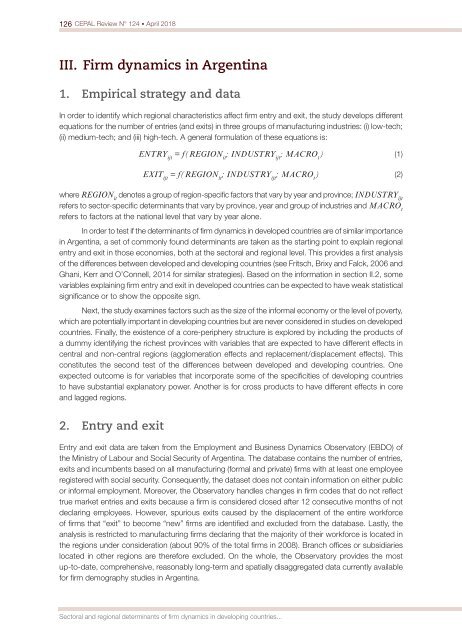CEPAL Review no. 124
April 2018
April 2018
Create successful ePaper yourself
Turn your PDF publications into a flip-book with our unique Google optimized e-Paper software.
126 <strong>CEPAL</strong> <strong>Review</strong> N° <strong>124</strong> • April 2018<br />
III. Firm dynamics in Argentina<br />
1. Empirical strategy and data<br />
In order to identify which regional characteristics affect firm entry and exit, the study develops different<br />
equations for the number of entries (and exits) in three groups of manufacturing industries: (i) low-tech;<br />
(ii) medium-tech; and (iii) high-tech. A general formulation of these equations is:<br />
ENTRY ijt<br />
= f(REGION it<br />
; INDUSTRY ijt<br />
; MACRO t<br />
) (1)<br />
EXIT ijt<br />
= f(REGION it<br />
; INDUSTRY ijt<br />
; MACRO t<br />
) (2)<br />
where REGION it<br />
de<strong>no</strong>tes a group of region-specific factors that vary by year and province; INDUSTRY ijt<br />
refers to sector-specific determinants that vary by province, year and group of industries and MACRO t<br />
refers to factors at the national level that vary by year alone.<br />
In order to test if the determinants of firm dynamics in developed countries are of similar importance<br />
in Argentina, a set of commonly found determinants are taken as the starting point to explain regional<br />
entry and exit in those eco<strong>no</strong>mies, both at the sectoral and regional level. This provides a first analysis<br />
of the differences between developed and developing countries (see Fritsch, Brixy and Falck, 2006 and<br />
Ghani, Kerr and O’Connell, 2014 for similar strategies). Based on the information in section II.2, some<br />
variables explaining firm entry and exit in developed countries can be expected to have weak statistical<br />
significance or to show the opposite sign.<br />
Next, the study examines factors such as the size of the informal eco<strong>no</strong>my or the level of poverty,<br />
which are potentially important in developing countries but are never considered in studies on developed<br />
countries. Finally, the existence of a core-periphery structure is explored by including the products of<br />
a dummy identifying the richest provinces with variables that are expected to have different effects in<br />
central and <strong>no</strong>n-central regions (agglomeration effects and replacement/displacement effects). This<br />
constitutes the second test of the differences between developed and developing countries. One<br />
expected outcome is for variables that incorporate some of the specificities of developing countries<br />
to have substantial explanatory power. A<strong>no</strong>ther is for cross products to have different effects in core<br />
and lagged regions.<br />
2. Entry and exit<br />
Entry and exit data are taken from the Employment and Business Dynamics Observatory (EBDO) of<br />
the Ministry of Labour and Social Security of Argentina. The database contains the number of entries,<br />
exits and incumbents based on all manufacturing (formal and private) firms with at least one employee<br />
registered with social security. Consequently, the dataset does <strong>no</strong>t contain information on either public<br />
or informal employment. Moreover, the Observatory handles changes in firm codes that do <strong>no</strong>t reflect<br />
true market entries and exits because a firm is considered closed after 12 consecutive months of <strong>no</strong>t<br />
declaring employees. However, spurious exits caused by the displacement of the entire workforce<br />
of firms that “exit” to become “new” firms are identified and excluded from the database. Lastly, the<br />
analysis is restricted to manufacturing firms declaring that the majority of their workforce is located in<br />
the regions under consideration (about 90% of the total firms in 2008). Branch offices or subsidiaries<br />
located in other regions are therefore excluded. On the whole, the Observatory provides the most<br />
up-to-date, comprehensive, reasonably long-term and spatially disaggregated data currently available<br />
for firm demography studies in Argentina.<br />
Sectoral and regional determinants of firm dynamics in developing countries...


















